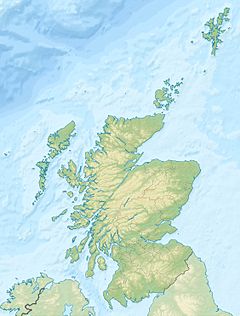- Boreray, St Kilda
-
Not to be confused with Boreray, North Uist.
Boreray Location Boreray shown within Scotland OS grid reference NA153053 Names Gaelic name Boraraigh Meaning of name "Fort island", from Norse Area and summit Area 86 ha (0.33 sq mi)[1] Area rank 154= Highest elevation Mullach an Eilein 384 m (1,260 ft) Population Population 0 Population rank 0 out of 97 Groupings Island group St Kilda Local Authority Na h-Eileanan Siar 

References [2][3][4][5] If shown, area and population ranks are for all Scottish islands and all inhabited Scottish islands respectively. Population data is from 2001 census. Boreray (Scottish Gaelic: Boraraigh, pronounced [pɔrˠarˠɤi]) is an uninhabited island in the St Kilda archipelago in the North Atlantic.
Contents
Geography
Boreray lies about 66 km (41 mi) west-north-west of North Uist. It covers about 77 hectares (0.30 sq mi), and reaches a height of 384 metres (1,260 ft) at Mullach an Eilein.
Mullach an Eilein Elevation 384 m (1,260 ft) Prominence 384 m (1,260 ft) Listing Marilyn Translation Top/upper part of the island (Scottish Gaelic) Pronunciation Scottish Gaelic: [ˈmul̪ˠəx ən̪ˠ ˈjeʎɛɲ] Location Location St Kilda, Scotland Coordinates 57°52′11″N 08°29′26″W / 57.86972°N 8.49056°W Topo map OS Landranger 18 OS grid NA153053 Boreray is formed of a breccia of gabbro and dolerites.[1]
There are two sea stacks, vertical pillars of rock, just off Boreray. Stac An Armin, (¼ mi) to the north, is the taller at 196 metres (643 ft) high, while Stac Lee, 600 m (660 yards) to the west, is 172 metres (564 ft) high.
Boreray is the smallest of the Scottish islands to have a summit over one thousand feet.
History
Boreray boasts the Cleitean MacPhàidein, a "cleit village" of three small bothies used on a regular basis during fowling expeditions from Hirta.[6] As a result of a smallpox outbreak on Hirta in 1724, three men and eight boys were marooned on Boreray until the following May.[7]
Here too are the ruins of Taigh Stallar (the steward's house), which was similar to the Amazon's house in Gleann Mòr, Hirta although somewhat larger, and which had six bed spaces. The local tradition was that it was built by the "Man of the Rocks", who led a rebellion against the landlord's steward.[6] It may be an example of an Iron Age wheelhouse and the associated remains of an agricultural field system and two additional possible settlement mounds were discovered in 2011.[8][9][10] RCAHMS surveyor Ian Parker said: “This new discovery shows that a farming community actually lived on Boreray, perhaps as long ago as the prehistoric period. The agricultural remains and settlement mounds give us a tantalising glimpse into the lives of those early inhabitants. Farming what is probably one of the most remote – and inhospitable – islands in the North Atlantic would have been a hard and gruelling existence. And given the island’s unfeasibly steep slopes, it’s amazing that they even tried living there in the first place.”[9]
Macauley (1764) reported the existence of five druidic altars in the islands including a large circle of stones fixed perpendicularly in the ground, by the Stallar House.[11]
The islands were bought in 1931 by the ornithologist, John Crichton-Stuart, 5th Marquess of Bute. In 1957, following his death, they were bequeathed to the National Trust for Scotland (NTS), the current owner.[1]
St Kilda was inscribed by UNESCO as a World Heritage Site in 1986 in recognition of its Natural Heritage; for its exceptional natural beauty and for the significant natural habitats that it supports. In July 2004 this was extended to include the surrounding marine environment. In July 2005 further recognition for the islands cultural heritage was awarded making it one of only a few places in the world with Dual World Heritage Status for both its natural and cultural significance.[12]
Wildlife
Boreray's cliffs are home for various seabirds. In 1959, 45,000 pairs of gannets were counted on the island and the two stacks. There are also over 130 different varieties of flowering plant on the island.[3] The island is also the home to an extremely rare breed of sheep, also called Boreray.
See also
- List of outlying islands of Scotland
Footnotes
- ^ a b c "World Heritage Sites Protected Areas Programme - St Kilda". United Nations Environment Programme. http://www.unep-wcmc.org/sites/wh/pdf/ST.KILDA%20.pdf. Retrieved 2008-01-05.
- ^ 2001 UK Census per List of islands of Scotland
- ^ a b Haswell-Smith (2004) pp. 323-36
- ^ Ordnance Survey
- ^ Iain Mac an Tailleir. "Placenames". Pàrlamaid na h-Alba. http://www.scottish.parliament.uk/vli/language/gaelic/pdfs/placenamesA-B.pdf. Retrieved 2007-07-28.
- ^ a b Maclean (1977) page 28.
- ^ Maclean (1977) pages 48–9
- ^ Fleming (2005) page 58.
- ^ a b "Evidence of Ancient Settlement Found on Boreray". (16 June 2011) RCHAMS. Retrieved 19 June 2011.
- ^ "Prehistoric finds on remote St Kilda's Boreray isle". (17 June 2011) BBC News. Retrieved 19 June 2011.
- ^ Macauley, Rev Kenneth (1764) History of St Kilda. London
- ^ "St Kilda". National Trust for Scotland. http://www.kilda.org.uk/. Retrieved 2008-01-05.
References
- Fleming, Andrew (2005) St. Kilda and the Wider World: Tales of an Iconic Island, Windgather Press ISBN 1905119003
- Haswell-Smith, Hamish (2004). The Scottish Islands. Edinburgh: Canongate. ISBN 1841954543.
- Maclean, Charles (1977) Island on the Edge of the World: the Story of St. Kilda, Edinburgh, Canongate ISBN 0903937417
Coordinates: 57°52′11″N 08°29′26″W / 57.86972°N 8.49056°W
Islands Boreray/Boraraigh · Dùn · Hirta · Soay/Soaigh · Stac an Armin/Stac an Àrmainn · Stac Biorach · Stac Lee/Stac Lì · Stac Levenish/Stac LeibhinisEndemic Fauna History Clan MacLeod · Lady GrangeCategories:- St Kilda, Scotland
- Uninhabited islands of Scotland
- Seabird colonies
Wikimedia Foundation. 2010.


